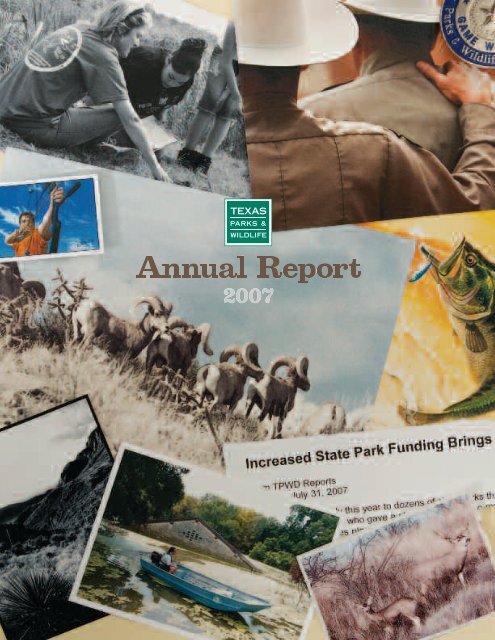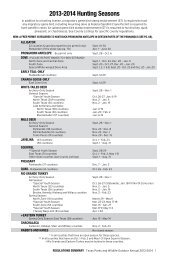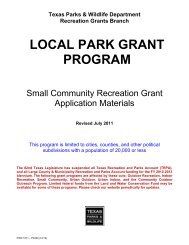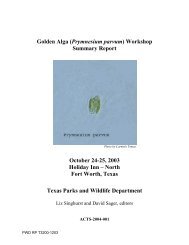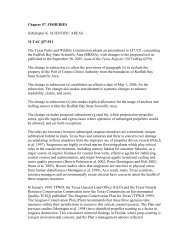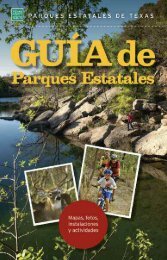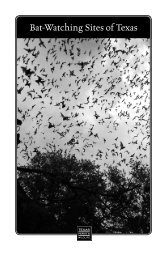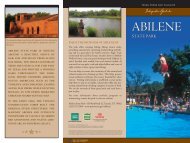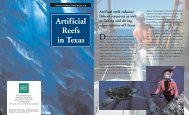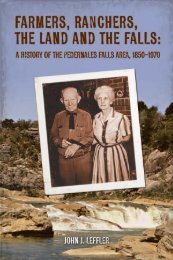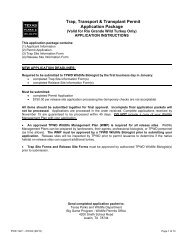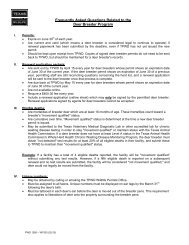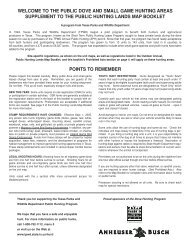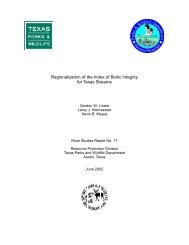2007 TPWD Annual Report - Texas Parks & Wildlife Department
2007 TPWD Annual Report - Texas Parks & Wildlife Department
2007 TPWD Annual Report - Texas Parks & Wildlife Department
You also want an ePaper? Increase the reach of your titles
YUMPU automatically turns print PDFs into web optimized ePapers that Google loves.
CONTENTS<br />
4 Legislature and Voters Provide New Funding<br />
5 Staff Implements Audit Recommendations<br />
6 Game Wardens Weather Tragedy, Look Ahead<br />
8 Agency Leadership Changes<br />
9 Outdoor Recreation Opportunities for All Texans<br />
10 Expanded Access to Outdoor Recreation<br />
11 Managing and Promoting Recreational Sites<br />
12 Increased Participation in Outdoor Recreation<br />
14 Enhancements to Hunting, Fishing, Boating and<br />
Outdoor Recreation<br />
15 Land and Water Initiatives<br />
Land Conservation Milestones<br />
16 Water Initiatives to Support Fish, <strong>Wildlife</strong> and Recreation<br />
18 Inside the Agency<br />
Streamlining Business Management Systems<br />
19 Valuing and Retaining Employees<br />
20 Employee Recognition Awards<br />
22 <strong>TPWD</strong> Leadership<br />
23 TPW Commissioners<br />
24 Accountability Measures
To The People of <strong>Texas</strong><br />
From the Chairman and the Executive Director<br />
Fiscal Year <strong>2007</strong> was a year of extremes, from droughts to flooding; from budget struggles to an<br />
inflow of muchneeded funding; from tragedy to renewal. It was a year of coming together and<br />
sharpening our focus as we worked together with diverse communities, landowners and other<br />
agencies and to fulfill our mission.<br />
The 80th <strong>Texas</strong> Legislature provided approximately $182 million in additional funding for state<br />
park operations and maintenance, as well as funding for a new fish hatchery, water initiatives,<br />
law enforcement and border security. We were very grateful to receive this funding, which will<br />
make a positive difference in the level of services we are able to provide and the economic<br />
returns to local communities.<br />
Of the total funding appropriated by the <strong>Texas</strong> Legislature, $52 million was approved by voters in<br />
fall <strong>2007</strong> with the passage of Proposition 4. This constitutional amendment, which provided up to<br />
$1 billion in bond authority for 11 state agencies, would not have passed without your support. We<br />
offer a big “thank you” to all who voted for Proposition 4.<br />
The State Auditor’s Office conducted an audit of state parks, and we are working to implement<br />
the recommendations outlined in the audit report. We welcome this opportunity to improve<br />
our business operations.<br />
When two game wardens died in the line of duty in spring <strong>2007</strong>, game wardens and citizens across<br />
the state pulled together to honor and respect those who had lost their lives. We deeply<br />
appreciated your support during that difficult time.<br />
Despite the challenges we faced, we continued to implement the goals of the Land and Water<br />
Resources Conservation and Recreation Plan, the strategic operating plan that guides our work.<br />
Through dedicated teamwork and by building partnerships with landowners, we strengthened our<br />
work to facilitate land and water conservation and provided outdoor recreation opportunities for<br />
more diverse groups than ever before.<br />
As our population becomes increasingly urban, it is more important than ever that we maintain<br />
our parks, fresh water, and high quality of service. In the coming year, we will continue to fulfill<br />
our mission to provide hunting, fishing and outdoor recreation opportunities and to help conserve<br />
the natural beauty of our state for present and future generations.<br />
Peter M. Holt<br />
Chairman<br />
Robert L. Cook<br />
Executive Director
Legislature and Voters<br />
During the 80th session of the <strong>Texas</strong> Legislature, the spotlight was on state parks.<br />
The <strong>Texas</strong> <strong>Parks</strong> and <strong>Wildlife</strong> <strong>Department</strong>’s Legislative Appropriations<br />
Request for the 2008 – 2009 biennium outlined funding needs for state<br />
parks and for other areas, as well. <strong>TPWD</strong> staff, along with the State<br />
<strong>Parks</strong> Advisory Committee and other officials, worked hard to provide<br />
legislators with the information they needed to make decisions about<br />
the agency’s funding priorities. The outcome was very positive overall<br />
for <strong>TPWD</strong>, as the Legislature appropriated the largest amount of new<br />
funding in decades to support state parks, fisheries and law<br />
enforcement, and passed legislation to help ensure sufficient water flows<br />
to support fish and wildlife.<br />
The Legislature approved approximately $182 million in new funding<br />
and bonds for state park operations and staffing, including the addition<br />
of 229 fulltime positions; minor and major repairs; capital equipment<br />
and land acquisition; and local park grants. The funding also allows for<br />
new positions in the Infrastructure Division to support the increased<br />
funding for capital repair projects in state parks. In other parkrelated<br />
legislation, House Bill (HB) 12 transferred 18 state historic sites from<br />
<strong>TPWD</strong> to the <strong>Texas</strong> Historical Commission. Senate Bill (SB) 1659<br />
transferred the <strong>Texas</strong> State Railroad to a new railroad authority.<br />
The Legislature appropriated $12.3 million from Freshwater Fishing<br />
Stamp funds to support the construction of a new fish hatchery in East<br />
<strong>Texas</strong>. To support <strong>TPWD</strong>’s work on the front lines of conservation,<br />
$2 million was provided for Law Enforcement Division general operations,<br />
as well as an additional $2.1 million through the Border Security Initiative,<br />
to fund 15 new game warden positions along the <strong>Texas</strong>Mexico border.<br />
In addition, <strong>TPWD</strong> received funding and three staff positions to<br />
participate in a major water resources initiative outlined in SB 3, which<br />
provides new measures to manage instream flows and freshwater<br />
inflows to bays and estuaries. SB 3 also established a statewide<br />
Environmental Flows Advisory Group, which will include a <strong>TPWD</strong><br />
representative and will develop environmental flow recommendations<br />
for consideration by the <strong>Texas</strong> Commission on Environmental Quality.<br />
“The outcome was<br />
very positive<br />
overall for <strong>TPWD</strong>,<br />
as the Legislature<br />
appropriated the<br />
largest amount of<br />
new funding in<br />
decades to support<br />
state parks,<br />
fisheries and law<br />
enforcement, and<br />
passed legislation<br />
to help ensure<br />
sufficient water<br />
flows to support<br />
fish and wildlife.”<br />
The Legislature also passed HB 3249, which changed the agency’s<br />
Sunset date from September 1, 2013 to September 1, 2009. The Sunset<br />
process consists of regular assessments of state agency programs by the<br />
Sunset Advisory Commission. Sunset provides legislators with the<br />
opportunity to review each agency closely and make changes to an<br />
agency’s mission or operations if needed. Following the passage of<br />
HB 3249, <strong>TPWD</strong> staff worked hard over the summer to produce the<br />
SelfEvaluation <strong>Report</strong> required of all agencies that will be undergoing<br />
Sunset review during FY08. The report was submitted to the Sunset<br />
Advisory Commission in August <strong>2007</strong>.<br />
<strong>TPWD</strong> 4 FY07
Provide New Funding<br />
Staff Implements Audit Recommendations<br />
In March <strong>2007</strong> the State Auditor’s Office completed an audit report<br />
on <strong>TPWD</strong> financial processes. In the report, auditors recommended<br />
that <strong>TPWD</strong> improve the accuracy of its park revenue and visitation<br />
reporting, and of its management and operation of state parks. The<br />
report also made recommendations for improving the cost estimate<br />
process and prioritization of capital repair needs, and for correcting<br />
financial control weaknesses in state park operations.<br />
“We take this report seriously, and staff concurs with the majority of the<br />
recommendations for improvement that were made,” said Executive<br />
Director Robert L. Cook. “We have taken comprehensive measures to<br />
address the problems that were identified. We see this as an opportunity<br />
to improve and streamline some of our key business functions.”<br />
Agency staff responded quickly to address the audit findings and<br />
recommendations. To strengthen park accounting and reporting, <strong>TPWD</strong><br />
created a new Park Revenue and Visitation Accounting branch in the<br />
Administrative Resources Division staffed with 11 accountants. The<br />
agency’s Internal Audit staff will monitor the system closely to ensure<br />
that the new controls are effective. Park user surveys and marketing<br />
plans are also being developed to support the strategic management and<br />
visitation reporting of state parks.<br />
The Infrastructure Division staff is developing and putting into place<br />
new project management processes for evaluating whether a capital<br />
repair project is needed, and for ensuring consistency in cost estimates<br />
for repair and construction projects.<br />
The agency held training sessions in fall <strong>2007</strong> to familiarize state park<br />
employees and others with the new financial controls <strong>TPWD</strong> is<br />
putting in place to implement all the SAO audit recommendations.<br />
The goal is improved processes for budget monitoring, capital project<br />
prioritization, revenue enhancement and fiscal controls, many of which<br />
are now in place.<br />
VOTERS APPROVE<br />
PROPOSITION 4<br />
Of the $44 million allocated for major<br />
repairs to <strong>Texas</strong> state parks, $17 million<br />
will come from Proposition 8 bond<br />
funding approved by voters in 2001,<br />
and $27 million from Proposition 4<br />
bond funding approved in November<br />
<strong>2007</strong>. An additional $25 million of<br />
Proposition 4 bond money will be used<br />
for dryberthing and repairs to the<br />
Battleship TEXAS.<br />
<strong>TPWD</strong> 5 FY07
<strong>Texas</strong> <strong>Parks</strong> and <strong>Wildlife</strong> <strong>Department</strong> staff members pay their respects as the funeral procession of Game Warden Ty Patterson passes below.<br />
“They represented the best of <strong>Texas</strong> <strong>Parks</strong> and <strong>Wildlife</strong>, and they..<br />
were faithful public servants who cared deeply about our natural..<br />
resources and the people of <strong>Texas</strong>.”<br />
<strong>TPWD</strong> 6 FY07
In the coming year, the division<br />
will see an expansion of its crucial<br />
role in homeland security for the<br />
state of <strong>Texas</strong>.<br />
Game Wardens Weather<br />
Tragedy, Look Ahead<br />
Spring <strong>2007</strong> was a difficult time for<br />
the Law Enforcement Division as<br />
staff dealt with the loss of game<br />
wardens Justin Hurst and Teyran<br />
“Ty” Patterson, who died in the line<br />
of duty. Hundreds of game wardens<br />
and citizens from across the state<br />
attended the funeral services to pay<br />
their respects and show their support for the family members. On<br />
August 16, Hurst and Patterson were honored with the <strong>Texas</strong> <strong>Parks</strong><br />
and <strong>Wildlife</strong> <strong>Department</strong>’s Memorial Cross. In October <strong>2007</strong>, the<br />
Peach Point <strong>Wildlife</strong> Management Area was renamed the Justin<br />
Hurst <strong>Wildlife</strong> Management Area in recognition of Hurst’s passion<br />
for waterfowl and marsh habitats.<br />
The 80th Legislature designated<br />
$2.1 million in new funding for<br />
15 additional game warden<br />
positions along the <strong>Texas</strong>Mexico<br />
border. These additional positions<br />
will help ensure border security<br />
and will support the conservation<br />
of natural resources in those<br />
areas. Also on the horizon is the<br />
construction of a new <strong>Texas</strong><br />
Game Warden Academy in<br />
Hamilton County.<br />
“We are going to miss these courageous game wardens,” said <strong>TPWD</strong><br />
Law Enforcement Division Director, Colonel Pete Flores. “They<br />
represented the best of <strong>Texas</strong> <strong>Parks</strong> and <strong>Wildlife</strong>, and they were<br />
faithful public servants who cared deeply about our natural resources<br />
and the people of <strong>Texas</strong>.”<br />
On other fronts, game wardens conducted searchandrescue<br />
operations during the floods of <strong>2007</strong>, enforced fishing, hunting and<br />
boating safety laws, and helped law enforcement agencies apprehend<br />
criminals and stop the flow of illegal drugs into the state. Regular<br />
operations continued at the state’s 28 law enforcement offices. The<br />
division also continued to actively promote the diversity of cadets<br />
entering the <strong>Texas</strong> Game Warden Academy. In July <strong>2007</strong>, two cadets<br />
from the Mexican state of Nuevo Leon became the first foreign<br />
nationals to graduate from the academy. They will go on to pioneer<br />
conservation law enforcement in their state.<br />
<strong>TPWD</strong> 7 FY07
Agency Leadership Changes<br />
Fiscal Year <strong>2007</strong> brought major changes in the leadership of the <strong>Texas</strong> <strong>Parks</strong> and <strong>Wildlife</strong> <strong>Department</strong>.<br />
We said farewell to the chairman and vicechairman of the Commission, as well as to a third commissioner<br />
and our executive director.<br />
Governor Rick Perry named Peter Holt to the position<br />
of chairman and appointed three new Commission<br />
members. The Commission elected Dan Friedkin to<br />
serve as vicechairman. Our former executive director,<br />
Robert L. Cook, returned in an interim capacity in<br />
October until that position was filled.<br />
Joseph B.C. Fitzsimons, of San Antonio, was<br />
appointed to the Commission in 2001 and served as<br />
chairman from 2003 – <strong>2007</strong>. Fitzsimons chaired the<br />
Commission’s Regulations Committee for several years<br />
and served on the Environmental Flows Advisory<br />
Committee. He was a strong leader who accomplished<br />
much and will be remembered for his accomplishments<br />
in expanding wildlife conservation, securing additional<br />
park funding, and educating others about the<br />
important role of private land management in<br />
protecting the state’s water resources.<br />
Donato D. Ramos, of Laredo, served as vicechairman of<br />
the Commission from 2005 – <strong>2007</strong> and was first<br />
appointed to the Commission in 2001. He chaired the<br />
Outreach and Education Committee and advocated for<br />
more hunting opportunities for youth. Ramos worked<br />
closely with commissioners and incoming ViceChairman<br />
Dan Friedkin to bring the Toyota <strong>Texas</strong> Bass Classic<br />
tournament to <strong>Texas</strong> in March <strong>2007</strong>.<br />
Ned S. Holmes was appointed to the Commission in 2003<br />
and served until <strong>2007</strong>, when Governor Perry appointed<br />
him to the <strong>Texas</strong> <strong>Department</strong> of Transportation<br />
Commission. He chaired the Commission’s Finance<br />
Committee and is a strong supporter of the new <strong>Texas</strong><br />
Game Warden Academy and other important causes<br />
related to the agency’s mission and goals.<br />
Executive Director Robert L. Cook retired from the<br />
agency in August <strong>2007</strong> following a career in conservation<br />
that spanned 42 years, including 31 years with <strong>TPWD</strong>.<br />
Over the past year, Cook worked tirelessly with agency<br />
staff to provide information to the Legislature regarding<br />
park funding needs and the waterquality issues outlined<br />
in SB 3. He will be remembered as a leader, mentor and<br />
friend to many within the agency, and as a “straight<br />
shooter” who had tremendous credibility with agency<br />
staff, the Commission and the Legislature.<br />
The incoming chair and three new members of the<br />
Commission bring a range of expertise and experience<br />
that is certain to infuse the agency with energy and new<br />
opportunities.<br />
Peter M. Holt was appointed chairman of the<br />
Commission in July <strong>2007</strong>. Holt, who has served as a<br />
Commission member since 2003, is CEO of San Antoniobased<br />
Caterpillar dealership The Holt Companies and is<br />
the chairman and principal owner of the San Antonio<br />
Spurs of the National Basketball Association.<br />
T. Dan Friedkin, first appointed to the Commission in<br />
2005, was elected vicechairman in August <strong>2007</strong>.<br />
Friedkin is President and Chief Executive Officer of<br />
Friedkin Companies. He is an avid outdoorsman who is<br />
active in wildlife conservation initiatives. He was<br />
instrumental in working with Commissioner Ramos to<br />
bring the Toyota <strong>Texas</strong> Bass Classic tournament to Lake<br />
Fork in March <strong>2007</strong>.<br />
Incoming Commission member Antonio Falcon, M.D.,<br />
was appointed in August <strong>2007</strong>. Falcon is a family<br />
physician and the medical director of the Family<br />
Health Center LLP in Rio Grande City. He is a<br />
presidential appointee to the United States Mexico<br />
Border Health Commission.<br />
Also new to the Commission is Karen J. Hixon, who was<br />
appointed in August <strong>2007</strong>. Hixon serves on the board of<br />
the Peregrine Fund based in Boise, Idaho, and on the<br />
advisory board for the Trust for Public Land and the<br />
Mitchell Lake Audubon Center. She is a past <strong>Texas</strong><br />
advisory member for Environmental Defense and past<br />
docent chairman of the San Antonio Zoological Society.<br />
Margaret Martin was appointed to the Commission in<br />
August <strong>2007</strong>. Martin is the owneroperator of a working<br />
ranch in Webb County and is developing a tea brokerage<br />
and export business. She has implemented a wildlife<br />
program and is developing a nature tourism project on<br />
her South <strong>Texas</strong> ranch.<br />
We offer heartfelt gratitude to<br />
each of these leaders, whose talent<br />
and contributions have greatly<br />
benefited our agency and the state<br />
of <strong>Texas</strong>.<br />
<strong>TPWD</strong> 8 FY07
Outdoor Recreation Opportunities for All Texans<br />
Despite the challenges that arose during Fiscal Year <strong>2007</strong>, <strong>TPWD</strong> sharpened its focus on the goals of the Land and Water<br />
Resources Conservation and Recreation Plan. Through dedicated hard work, and by strengthening public private partnerships,<br />
<strong>TPWD</strong> sustained and expanded hunting, fishing and outdoor recreation opportunities for all Texans. Staff expanded outreach<br />
efforts to a diverse and growing urban population in all program areas of the agency.
Expanded Access to Outdoor Recreation<br />
Providing access to outdoor recreation for all Texans is a primary goal of the Land and Water<br />
Resources Conservation and Recreation Plan. With this in mind, <strong>TPWD</strong> undertook a number of<br />
projects that increased outdoor recreation opportunities for a diverse, urban population.<br />
In fall <strong>2007</strong>, Resaca de la Palma State Park became the newest site to<br />
join the World Birding Center, bringing 1,700 new acres of semitropical<br />
land teeming with birds and wildlife to birdwatchers and the general<br />
public. The nine World Birding Center sites are located along the<br />
border of the South <strong>Texas</strong> valley from Roma to South Padre Island.<br />
The State <strong>Parks</strong>, Inland Fisheries, and Communications divisions<br />
collaborated to open and promote the new Goliad Paddling Trail in April<br />
<strong>2007</strong>, providing an exciting new water recreation opportunity for Texans.<br />
Located on the San Antonio River, Goliad became the third inland<br />
paddling trail in <strong>Texas</strong> and the first to be anchored by a state park.<br />
Together, the state’s three inland paddling trails and seven coastal<br />
paddling trails provide paddlers and anglers with recreational<br />
opportunities and a chance to learn about water issues involving <strong>Texas</strong><br />
rivers and lakes, and the Gulf of Mexico.<br />
The Gus A. Engeling <strong>Wildlife</strong> Conservation<br />
Center opened in May <strong>2007</strong> to provide<br />
landowners, local youth, and the general public<br />
with access to information and educational<br />
materials about wildlife research and habitat<br />
conservation at the Gus Engeling <strong>Wildlife</strong><br />
Management Area and surrounding properties.<br />
In West <strong>Texas</strong>, access will soon broaden in the vast 300,000acre Big<br />
Bend Ranch State Park. Staff members of the agency’s State <strong>Parks</strong> and<br />
Infrastructure divisions held public meetings in different areas of the<br />
state in FY07 to gather public input on a public use plan that is under<br />
development. Proposed improvements include converting old ranch<br />
roads to multiuse trails, expanding hunting opportunities, developing<br />
water sources in the park, adding new campsites, making more<br />
backcountry primitive roads available to the public, and expanding the<br />
park’s Web presence.<br />
According to State <strong>Parks</strong> Division Director Walt Dabney, “The<br />
expansion of public access in Big Bend Ranch State Park will allow us to<br />
provide a unique experience for a greater number of visitors seeking a<br />
rugged outdoor experience, while at the same time conserving the<br />
remoteness and natural beauty of the land.”<br />
In Fiscal Year <strong>2007</strong>, the agency awarded over $15 million in recreation<br />
grants to local communities, enabling them to provide access to more<br />
recreational opportunities for the Texans who live in those areas.<br />
Projects funded included outdoor and indoor recreational facilities,<br />
boating access facilities, recreational trails, and the community outdoor<br />
outreach programs to introduce underserved populations to the services,<br />
programs, and sites of the <strong>Texas</strong> <strong>Parks</strong> and <strong>Wildlife</strong> <strong>Department</strong>.<br />
The <strong>Wildlife</strong> Division expanded its dove<br />
lease program, adding five new counties<br />
that are each within an hour’s drive of a<br />
major city. This accomplishment supports<br />
the Land and Water Resources<br />
Conservation and Recreation Plan goal of<br />
providing access to hunting opportunities<br />
for diverse urban populations.<br />
<strong>TPWD</strong> 10 FY07
Managing and Promoting<br />
Recreational Sites<br />
<strong>TPWD</strong> continued to manage and operate statewide<br />
recreational sites serving more than 10 million visitors,<br />
and to promote them through outreach and marketing<br />
efforts. The State <strong>Parks</strong> and Infrastructure divisions<br />
operated and maintained 110 state parks, historic sites,<br />
state park/historic sites, and natural areas. The <strong>Wildlife</strong><br />
Division managed 51 wildlife management areas, the<br />
Inland Fisheries Division managed five hatcheries, and<br />
the Coastal Fisheries Division oversaw three hatcheries.<br />
The Communications Division managed the Parrie<br />
Haynes Ranch retreat and youth activity center.<br />
Extensive renovations to Indian Lodge at Davis Mountains State Park<br />
were unveiled on October 26, 2006. The fiveyear, $4.35million project<br />
restored the lodge, constructed by the Civilian Conservation Corps in the<br />
1930s, to its original appearance while upgrading its mechanical, plumbing<br />
and airconditioning systems. Following the reopening, Indian Lodge<br />
revenues from August 1, 2006 to July 31, <strong>2007</strong> have risen by $448,000 over<br />
the same period the previous year.<br />
In North <strong>Texas</strong>, parkgoers celebrated the opening of the Caprock Canyons<br />
State Park Visitor Center as well as the park’s 25th anniversary. In<br />
September, the San Jacinto Battleground State Historic Site Monument<br />
celebrated the reopening of its elevator, which carries visitors up the<br />
570foot monument to an observation floor overlooking the historic<br />
battleground. The reopening was the culmination of 10 years of<br />
renovations to the monument, which is revered as the tallest stone<br />
column memorial structure in the world.<br />
“We are thrilled to have completed these extensive projects and to be able<br />
to offer these improved facilities to <strong>Texas</strong> parkgoers,” said Infrastructure<br />
Division Director Stephen Whiston. “They will provide a better<br />
experience for Texans wanting to get outdoors and enjoy our state’s<br />
natural and cultural heritage.”<br />
The heavy rains of spring and summer <strong>2007</strong> caused extensive flood<br />
damage to facilities at Mother Neff and Palmetto state parks, among<br />
others. However, the rain was welcome relief from punishing drought<br />
conditions that had persisted for the last two years. In the late summer<br />
and early fall, Texans rushed to their favorite parks to enjoy lush foliage,<br />
rushing rivers and creeks and full lakes.<br />
Looking ahead, the millions of new dollars appropriated by the<br />
Legislature will allow for the most substantial increase in parks<br />
maintenance, staffing, equipment and operations that the agency has<br />
seen in decades. The $27 million in the Proposition 4 bonds approved by<br />
voters in November <strong>2007</strong> will allow for state park critical repairs, and an<br />
additional $25 million will allow for the preservation and dryberthing of<br />
a cultural treasure, the Battleship TEXAS.<br />
<strong>TPWD</strong> 11 FY07
The Communications Division promoted outdoor recreation through<br />
<strong>Texas</strong> <strong>Parks</strong> & <strong>Wildlife</strong> magazine, the outdoor magazine of <strong>Texas</strong> with<br />
over 144,000 readers. The March <strong>2007</strong> issue, featuring “50 Quick<br />
Getaways,” was the topselling issue of the year, reflecting the growing<br />
interest in outdoor recreation among urban Texans. The division also<br />
continued to produce the weekly PBS series <strong>Texas</strong> <strong>Parks</strong> & <strong>Wildlife</strong>,<br />
which offers compelling stories to get people outdoors to enjoy our<br />
natural heritage. The agency Web site continued to promote outdoor<br />
recreation and conservation to approximately 600,000 visitors per<br />
month. The agency also initiated a Webbased email subscription<br />
service to deliver customized recreation information directly to the<br />
customer. <strong>TPWD</strong> collaborated with <strong>Texas</strong> A&M University to produce a<br />
nature tourism video, which was distributed statewide.<br />
Increased Participation in<br />
Outdoor Recreation<br />
With the rapid urbanization of our population in <strong>Texas</strong>, the demand for outdoor experiences is<br />
greater than ever before. Last year, a record number of Texans participated in a wide range of<br />
outdoor recreational activities and <strong>TPWD</strong> events. <strong>Texas</strong> State <strong>Parks</strong> Pass sales continued to<br />
increase and were on track to surpass 74,917 sold in 2006.<br />
According to the 2006 National Survey of Fishing, Hunting, and <strong>Wildlife</strong><br />
Associated Recreation, Texans spent about $8.4 billion on fishing, hunting<br />
and wildliferelated activities in 2006. <strong>Texas</strong> led the nation in hunting in<br />
2006, with 1.1 million Texans hunting that year and about $2.3 billion in<br />
huntingrelated expenditures. While <strong>Texas</strong> has long been known as a<br />
“hunting state,” it is an “angling state,” as well. <strong>Texas</strong> ranked second in<br />
angling participation, with 2.5 million anglers going fishing and spending<br />
about $3.2 billion. <strong>Wildlife</strong>watchers ranked third in the nation, with<br />
4.17 million participants and expenditures of $2.9 billion.<br />
In April <strong>2007</strong> the Inland Fisheries<br />
Division, with support from the<br />
Communications Division, presented the<br />
threeday Toyota <strong>Texas</strong> Bass Classic, a<br />
major firstofitskind bass fishing<br />
tournament held on Lake Fork. The<br />
event, which offered a $1 million purse,<br />
attracted 27,500 visitors and 160<br />
professional anglers from all over the country and<br />
showcased <strong>TPWD</strong>’s innovative fisheries management. “The Toyota<br />
<strong>Texas</strong> Bass Classic was the first major bass tournament held on a lake<br />
intensively managed with a high slot limit,” said Inland Fisheries<br />
Director Phil Durocher. “Since most of the fish caught were in the<br />
protected slot and had to be immediately released, the competitors<br />
weighed them on the boat and received credit for the catch.” The focus<br />
was on conservation of the bass resource through proper handling of the<br />
fish—a new format that could have a positive impact on professional<br />
bass fishing. Sponsors of the event donated $250,000 to support <strong>TPWD</strong><br />
youth fishing and outreach programs.<br />
<strong>TPWD</strong> 12 FY07
The Communications Division<br />
partnered with the Lower Colorado<br />
River Authority (LCRA) to take the<br />
“Nobody’s Waterproof” marketing<br />
campaign statewide and support<br />
<strong>TPWD</strong>’s mandatory boater<br />
education program. Country music<br />
star Kevin Fowler joined the effort<br />
to get the message out to the primary target audience of 18to34yearold<br />
male boaters. Throughout the summer, the campaign outreach team<br />
took the “Nobody’s Waterproof” outreach boat to special water and<br />
shoreline events across the state to raise awareness about water safety<br />
by engaging people in fun, educational activities and social interaction.<br />
In March <strong>2007</strong>, <strong>TPWD</strong> hosted the International Boating and Water<br />
Safety Congress in San Antonio to highlight <strong>Texas</strong>’ efforts.<br />
The <strong>Texas</strong> Youth<br />
Hunting program<br />
celebrated 10 years<br />
of hunting last year.<br />
To date, the<br />
program has offered<br />
over 1,100 hunts to<br />
more than 11,000<br />
youth from diverse<br />
backgrounds, onethird<br />
of whom are<br />
from large innercity<br />
areas. Youth who<br />
participate in the hunts are required to bring an adult; in addition,<br />
volunteers are trained to assist with the hunts. All in all, including<br />
youth, adults, and volunteers, the program has introduced 32,692<br />
individuals to safe, educated and ethical hunting and provided them<br />
with outdoor experiences.<br />
The 16th annual <strong>Texas</strong> <strong>Parks</strong><br />
& <strong>Wildlife</strong> Expo drew over<br />
42,000 visitors, the largest<br />
crowd since 2002. The<br />
percentage of youth attending<br />
increased from 35 percent to<br />
51 percent. Attendees<br />
reflected the diversity of<br />
urban <strong>Texas</strong> more than ever<br />
before, with outreach buses<br />
traveling to the event from the Houston area, San Antonio and Laredo.<br />
<strong>TPWD</strong> received an award from the prestigious Weatherby Foundation<br />
International for providing a model for outdoor expos that has been<br />
emulated by 17 other states. Spain, Mexico and Austria are among other<br />
countries that are considering having similar events.<br />
RECORD TARPON CAUGHT!<br />
In October 2006, Deer Park angler Jeremy<br />
Ebert caught the largest tarpon on record<br />
in the state of <strong>Texas</strong> while fishing off the<br />
coast of Galveston. The tarpon weighed<br />
210 pounds, 11 ounces, and Ebert reeled<br />
in his catch after 45 minutes of struggling.<br />
<strong>TPWD</strong> 13 FY07
In 2006 <strong>TPWD</strong> assumed a statewide leadership role in the national<br />
Children & Nature Network (C&NN). C&NN provides resources to<br />
support people and organizations working to reconnect children with<br />
nature. Although the movement is in its early stages, it has already<br />
stimulated a groundswell of political support in many states. Through<br />
C&NN, agency staff are developing new partnerships and bringing new<br />
awareness to longstanding <strong>TPWD</strong> educational programs such as<br />
Archery in the Schools, Take Me Fishing, Becoming an Outdoors<br />
Family, and Project WILD. In FY07, these programs continued to draw<br />
in urban youth and families who may not have had previous outdoor<br />
recreational opportunities.<br />
Enhancements to Hunting, Fishing, Boating<br />
and Outdoor Recreation<br />
Maintaining healthy and sustainable ecosystems is crucial to providing highquality hunting, fishing<br />
and outdoor recreation opportunities. The agency implemented a number of initiatives to ensure<br />
that ecosystems remain balanced and participants have the best outdoor experiences possible.<br />
Project WILD reached the highest<br />
number of teachers and students since<br />
the program first came to <strong>Texas</strong> in 1986.<br />
More than 4,200 educators attended<br />
training workshops in fiscal year <strong>2007</strong>,<br />
up from about 2,900 the year before.<br />
In fall <strong>2007</strong> the Coastal Fisheries Division implemented a regional approach to<br />
spotted seatrout management in response to declining spotted seatrout<br />
population trends in the Lower Laguna Madre. The new management plan,<br />
which was adopted by the <strong>Texas</strong> <strong>Parks</strong> and <strong>Wildlife</strong> Commission in April <strong>2007</strong>,<br />
marks the first time a regional approach has been used on the coast and will<br />
utilize coastal fisheries data programs to determine spotted seatrout<br />
population trends.<br />
In addition, the division’s worldclass marine enhancement program continued<br />
to expand its capability to meet challenges such as red tide, hypoxia, and<br />
changes in fish species brought about by climate change. “We are shifting our<br />
focus and philosophy to be able to respond quickly and proactively to the effects<br />
of climate change,” said Coastal Fisheries Division Director Larry McKinney.<br />
“An enhanced capacity for flexible and rapid response means our hatcheries can<br />
make a significant contribution to recovery from major events such as freezes<br />
and pollution, and keep our marine fisheries healthy and productive.”<br />
Fiscal Year <strong>2007</strong> was a record bass production year for the Inland Fisheries<br />
Division. <strong>TPWD</strong>’s five inland fish hatcheries produced more than 8 million<br />
largemouth bass, in addition to 2.4 million catfish, 4.6 million striped bass and<br />
hybrid striped bass, and millions of other fish for stocking into <strong>Texas</strong> rivers,<br />
lakes and reservoirs.<br />
The Legislature provided $12.3 in new funding that will speed up progress on<br />
the construction of a new East <strong>Texas</strong> fish hatchery that is underway in Jasper<br />
County. The funding, which comes from Freshwater Fishing Stamp funds, will<br />
supplement money already budgeted by <strong>TPWD</strong> for the project.<br />
In fall 2006 new buck deer antler restrictions were expanded from 21 to 61<br />
counties in order to improve the age structure of the buck herd while increasing<br />
hunter opportunities. The regulations protect all branchedantlered bucks with<br />
an inside spread of less than 13 inches wide, which represent a large portion of<br />
the immature bucks in <strong>Texas</strong>. Hunting opportunity was increased by allowing<br />
hunters to take an additional unbranchedantlered buck (e.g., spike buck). This<br />
regulation has proven effective, and the agency continues to receive requests for<br />
further expansion of this unique regulated harvest strategy.<br />
<strong>TPWD</strong> 14 FY07
In late <strong>2007</strong> <strong>TPWD</strong> added the USTS <strong>Texas</strong> Clipper to its ShipstoReefs program by reefing the<br />
venerable ship 17 miles off the <strong>Texas</strong> coast in the Gulf of Mexico, near Brazos Santiago Pass.<br />
Preparations for the sinking, including the removal of hazardous and nonhazardous materials, had<br />
been underway since 1998. In addition to providing new habitat for fish, the reef will expand<br />
recreational opportunities for divers, and fishing opportunities for anglers, which should generate<br />
an estimated additional $50 million in tourism revenue for local economies.<br />
Land and Water Initiatives<br />
Because more than 90 percent of <strong>Texas</strong> is privately owned, building partnerships with landowners is an important part of<br />
<strong>TPWD</strong>’s work to ensure sustainable wildlife habitat. The <strong>Wildlife</strong> Division continued to provide technical assistance to<br />
landowners requesting support for their work as committed land stewards. The most significant challenges to freshwater<br />
and saltwater systems in <strong>Texas</strong> are reduced water quality and decreased water quantity. In response to these challenges,<br />
water initiatives were at the forefront of the agency’s work in <strong>2007</strong>.<br />
Land Conservation Milestones<br />
The <strong>Wildlife</strong> Division staff increased their work assisting landowners in managing their lands for<br />
sustainable wildlife habitat to meet their goals, through initiatives such as the Landowner<br />
Incentive Program and the annual Lone Star Land Steward Awards. The division also continued<br />
to implement the <strong>Wildlife</strong> Action Plan and its land conservation initiatives.<br />
The division continued its work with the <strong>Texas</strong> Panhandle Prescribed<br />
Burn Association to put into place a cooperative model that allows<br />
landowners to improve their habitat through prescribed burning and to<br />
share in the cost of equipment and resources. The division is working<br />
to share the successes of the association, which was started in 2005,<br />
and to use it as a model for prescribed burn associations in other areas<br />
of the state.<br />
In November 2006, <strong>TPWD</strong> and the U.S. Fish and <strong>Wildlife</strong> Service<br />
entered into an agreement that is intended to help landowners conserve<br />
the lesser prairie chicken. Under the agreement, landowners who take<br />
voluntary conservation measures, such as brush control, prescribed<br />
burning, grazing management, and periodic monitoring would be exempt<br />
from additional land use restrictions and conditions should the species<br />
ever be declared threatened or endangered.<br />
Over the next three years, researchers from Stephen F. Austin State<br />
University will track and study Eastern wild turkeys in Nacogdoches,<br />
Anderson and Houston counties to try to determine the effects on the<br />
birds of various management strategies. The study follows up on a<br />
restoration partnership that began 10 years ago when <strong>TPWD</strong>, private<br />
landowners and the National Wild Turkey Federation began an initiative<br />
to restore Eastern wild turkeys to suitable habitat. While some turkeys<br />
have done well, others have been less successful. The study will help<br />
researchers and biologists better determine what constitutes sustainable<br />
habitat. In addition, studies of Rio Grande wild turkeys are being<br />
conducted in other parts of the state.<br />
<strong>TPWD</strong> 15 FY07
Land conservation initiatives have resulted in the increased numbers of<br />
some bird species. A record 237 whooping cranes were recorded in winter<br />
2006, up from 220 the previous year. Whooping cranes have experienced a<br />
gradual comeback from nearextinction, thanks to legislation, conservation<br />
efforts and public awareness. The blackcapped vireo has made a comeback<br />
in <strong>Texas</strong> as a result of <strong>TPWD</strong>’s cowbird trapping training program, offered<br />
free of charge to landowners, which effectively reduces cowbird parasitism<br />
on songbirds. Nationally, the bald eagle was removed from the Endangered<br />
Species List in June <strong>2007</strong>, signifying the success of efforts at the state level<br />
to protect the birds’ habitat and help them recover.<br />
Governor Rick Perry attended the<br />
agency’s 12th annual Lone Star Land<br />
Steward Awards program, which honors<br />
private landowners for their efforts in<br />
conservation and habitat management.<br />
In addition to recognizing 10 ecoregion<br />
winners, <strong>TPWD</strong> and the Sand County<br />
Foundation bestowed the Leopold<br />
Conservation Award on the 77 Ranch,<br />
located south of Dallas. “The Price’s<br />
model ranching operation shows how<br />
landowners can manage their land in<br />
ways that benefit wildlife and the<br />
environment,” said <strong>Wildlife</strong> Division<br />
Director Mike Berger. “We are proud to<br />
participate in the <strong>Texas</strong> <strong>Parks</strong> and<br />
<strong>Wildlife</strong> tradition of honoring examples<br />
of sustainable conservation that can<br />
serve as models for other landowners.”<br />
In May <strong>2007</strong>, the <strong>Texas</strong> <strong>Parks</strong> and <strong>Wildlife</strong> Commission approved a<br />
“white list” of 84 nongame species that can be collected from private<br />
property in <strong>Texas</strong> and sold commercially. The measure, which became<br />
effective in late October <strong>2007</strong>, supports the agency’s <strong>Wildlife</strong> Action Plan<br />
and is intended to protect those species not included on the list,<br />
particularly wild turtles. In recent years there has been an increasing<br />
trend in the commercial collection and sale of wild turtles, snakes and<br />
other nongame animals, in response to a growing demand for turtle meat<br />
in China and other Asian markets.<br />
Water Initiatives to Support Fish, <strong>Wildlife</strong><br />
and Recreation<br />
<strong>TPWD</strong> broadened its work to improve water quality and wildlife habitat through watershed<br />
management and wetland restoration. The agency also became involved in new initiatives to<br />
manage instream and freshwater flows to sustain aquatic life.<br />
The 80th <strong>Texas</strong> Legislature adopted Senate Bill (SB) 3, which provides<br />
groundbreaking measures to manage instream flows and freshwater<br />
inflows to bays and estuaries. As the population of <strong>Texas</strong> doubles over the<br />
next 30 years, the pressure will increase to divert more and more water to<br />
meet those needs. SB 3 provides a framework for deciding how much<br />
water should remain in our state’s aquatic ecosystems to keep them<br />
ecologically sound, and how best to incorporate those needs into water<br />
permitting and allocation decisions. <strong>TPWD</strong>’s role will be to support the<br />
process and refine the science necessary to meet those goals. SB 3 also<br />
established a statewide Environmental Flows Advisory Group, which will<br />
include a <strong>TPWD</strong> representative and will develop environmental flow<br />
recommendations for consideration by the <strong>Texas</strong> Commission on<br />
Environmental Quality.<br />
In September 2006 Governor Rick Perry announced the Trinity River<br />
Environmental Project, a major initiative to improve the ecology and<br />
economic sustainability of the Trinity River Basin. <strong>TPWD</strong> is a partner in<br />
the initiative, which will build on the agency’s leadership role over the last<br />
five years in a collaborative effort to restore wetlands along the Trinity,<br />
including public land such as the Richland Creek <strong>Wildlife</strong> Management<br />
Area. The goals of the new project include setting new policy, leveraging<br />
federal funding for projects, and conducting effective outreach with<br />
landowners and other stakeholders.<br />
<strong>TPWD</strong> 16 FY07
The Communications Division continued its water communications initiative<br />
with the publication of “The State of Lakes,” the annual July waterthemed<br />
issue of <strong>Texas</strong> <strong>Parks</strong> & <strong>Wildlife</strong> magazine. In February, the division aired<br />
“<strong>Texas</strong>: The State of Springs,” narrated by Walter Cronkite, the third in a<br />
series of water documentaries. “With the water communications initiative,<br />
we are using all media available to get the word out about the water<br />
challenges facing our state,” said Communications Division Director<br />
Lydia Saldaña. “Water for wildlife and water for people are not mutually<br />
exclusive, and we hope that by providing information about how everyone can<br />
get involved in water conservation, we can all become part of the solution.”<br />
The Brays Bayou/Mason Park wetlands project, a multipartner, fiveyear<br />
project that was completed in October 2006, has garnered several awards<br />
and was featured in a Sierra Club report focusing on outstanding models of<br />
environmentally sensitive stormwater management. The project began in<br />
2001 when <strong>TPWD</strong> made a recommendation to park staff to create wetlands<br />
as part of the project and subsequently obtained an EPA grant to develop<br />
the wetlands.<br />
In January <strong>2007</strong> the largest episode of coldstunned sea turtles ever<br />
recorded in <strong>Texas</strong> occurred. Approximately 130 lethargic juvenile green sea<br />
turtles drifted onto shorelines in the Lower Laguna Madre when a severe<br />
cold front caused a sudden drop in water temperature. Coastal Fisheries<br />
staff transported 90 of the turtles to the division’s CCA/CPL Marine<br />
Development Center in Flour Bluff and to the <strong>Texas</strong> State Aquarium in<br />
Corpus Christi in an effort to save their lives. After rehabilitating the green<br />
sea turtles for a month in climatecontrolled indoor tanks, hatchery staff<br />
transported the animals to Port Isabel, where they were placed on a Coastal<br />
Fisheries research vessel and released back into the Lower Laguna Madre.<br />
Green sea turtles are federally listed as a threatened species.<br />
“Water for wildlife<br />
and water for<br />
people are not<br />
mutually exclusive,<br />
and we hope that<br />
by providing<br />
information about<br />
how everyone can<br />
get involved in<br />
water conservation,<br />
we can all become<br />
part of the<br />
solution.” Lydia Saldaña<br />
<strong>TPWD</strong> announced funding of up to $450,000 in state and federal matching<br />
grants to begin research projects on golden alga in September <strong>2007</strong>.<br />
Research priorities were developed by the <strong>TPWD</strong> Golden Alga Task Force.<br />
The goal of the task force is to conduct research and develop strategies to<br />
protect aquatic ecosystems by understanding toxic golden algal blooms and<br />
taking steps to mitigate their impacts. Golden alga levels fluctuate, and high<br />
levels have been known to be responsible for fish kills in <strong>Texas</strong> lakes and<br />
river systems.<br />
As one of 14 states to receive grant funding totaling $18.8 million from the<br />
U.S. Fish and <strong>Wildlife</strong> Service, <strong>TPWD</strong> is partnering with the Guadalupe<br />
Blanco River Authority and GuadalupeBlanco River Trust on a project to<br />
protect coastal wetland habitat in the delta where the Guadalupe River<br />
flows into San Antonio Bay.<br />
<strong>TPWD</strong> entered into an agreement with the Lower Neches Valley Authority<br />
and Ducks Unlimited (DU) to preserve a wetland complex within the Alazan<br />
Bayou <strong>Wildlife</strong> Management Area in East <strong>Texas</strong>, a popular waterfowl<br />
hunting and birdwatching area. The new agreement was a milestone in a<br />
partnership between <strong>TPWD</strong> and DU that has spanned 20 years and resulted<br />
in contributions from DU totaling $10 million to conserve 161,330 acres under<br />
the North American Waterfowl Management Plan from 1986 – 2006.<br />
<strong>TPWD</strong> 17 FY07
Inside the Agency<br />
The highquality programs and services that <strong>TPWD</strong> provides to the people of <strong>Texas</strong> would not be possible without a strong<br />
internal support system and a high level of employee satisfaction. The agency continuously endeavors to improve its<br />
business systems and to provide a meaningful, productive environment for its most valuable resources—its people.<br />
Streamlining Business Management Systems<br />
Maintaining effective business systems is crucial to <strong>TPWD</strong>’s ability to conduct business<br />
and communicate with its field staff across the state. Agency staff put in countless hours<br />
working on several major projects designed to streamline and refine the agency’s<br />
automated business systems.<br />
The Information Technology, State <strong>Parks</strong> and Administrative Resources<br />
divisions worked hard to develop the requirements and solicitation for a<br />
new state parks reservations system. The goal of this effort is to<br />
strengthen fiscal controls and improve park management processes,<br />
primarily in response to the <strong>2007</strong> audit of the State <strong>Parks</strong> Division but<br />
also in order to implement a turnkey system that will carry the agency<br />
into the future. “We are attempting to put into place a new <strong>Texas</strong> state<br />
parks application to replace the current system that has reached the<br />
end of its life and can no longer be modified to meet our needs,” said<br />
Information Technology Division Director George Rios. “The new<br />
system will allow us to add the functionality necessary to address our<br />
business needs while allowing us the flexibility to meet new challenges.”<br />
The <strong>Texas</strong> <strong>Parks</strong> and <strong>Wildlife</strong> Commission adopted a number of changes<br />
to simplify the state’s fishing and hunting license system, including<br />
consolidating the multiple types and variations of the temporary fishing<br />
license into a single oneday license for all fishing, with anglers buying<br />
as many days as they need; and clarifying the special resident hunting<br />
license by replacing it with a senior resident hunting license and a youth<br />
hunting license. In addition, the Administrative Resources and<br />
Information Technology divisions collaborated on the development of a<br />
new Webbased hunting and fishing license system, which went into<br />
effect on Aug. 15, <strong>2007</strong>, with the start of 2008 license sales.<br />
Administrative Resources Division Director Mary Fields explains, “With<br />
the help of our vendor, Verizon, we have successfully implemented a<br />
Webbased system and new equipment that provides better support to<br />
our license sales agents and results in a better license buying experience<br />
for our hunting and angling customers.”<br />
The Coastal Fisheries Division collaborated with the GIS Lab’s<br />
Resource Information Systems on an online application that helps<br />
anglers determine where to fish by allowing users to query the catch<br />
rates in different areas, as well as to find descriptions of fish habitat<br />
and distribution.<br />
In response to HB 1516, passed by the Legislature in 2005, the<br />
Information Technology Division continued to implement the <strong>Texas</strong> data<br />
center consolidation, which affects the state’s 27 largest agencies. Staff<br />
<strong>TPWD</strong> 18 FY07
put in countless hours of work to ensure the smooth transition of agency<br />
servers and applications to the selected vendor, IBM. The legislation also<br />
requires state agencies to purchase automated information systems<br />
through contracts managed and negotiated by the <strong>Texas</strong> <strong>Department</strong> of<br />
Information Resources, which has resulted in changes to how <strong>TPWD</strong><br />
handles its procurements of those items and services. The data center<br />
consolidation will continue through the next year.<br />
The Communications Division Web group developed an Accessibility<br />
Action Plan to ensure that the agency complies with recent legislation<br />
requiring that all electronic information be accessible to people with<br />
disabilities. A crossdivisional team is working to implement the plan,<br />
which will allow the agency to better serve all of its internal and<br />
external customers.<br />
Valuing and Retaining Employees<br />
<strong>TPWD</strong> is known for recruiting and retaining employees whose dedication, courage, and<br />
willingness to “go the extra mile” bring quality and passion to all areas of the agency. The 2006<br />
Survey of Organizational Excellence indicated that employees’ sense of responsibility to the<br />
organization increased by 15 percent, and scores improved in 17 of 20 areas of the survey.<br />
The Human Resources Division worked hard to provide support and<br />
services to <strong>TPWD</strong> staff, which was no easy task with an average ratio of<br />
one HR staff member to every 109 employees. “Last year, we focused on<br />
the basics—performance management, giving people the opportunity to<br />
give back, and providing ways for them to develop themselves<br />
professionally and physically,” said Human Resources Division Director<br />
Al Bingham.<br />
In 2006 the division revamped the performance management system to<br />
incorporate a competencybased approach and spent most of the year<br />
implementing the system and providing training to staff. The first<br />
evaluations using the new system began in fall <strong>2007</strong>. The longterm goal<br />
is to automate the performance management process and move to a<br />
paperless system.<br />
In <strong>2007</strong> graduates of the first six classes of <strong>TPWD</strong>’s Natural Leaders had<br />
the opportunity to renew their leadership development skills at a<br />
“refresh” event held at Camp Allen in July <strong>2007</strong>. <strong>TPWD</strong> started the<br />
Natural Leaders program in 2001 to support succession planning and<br />
prepare supervisors and program managers for current and future<br />
challenges. Each year, a class of candidates and mentors is selected for<br />
the yearlong program, which consists of leadership assessment and<br />
coaching, crossdivisional “stretch” projects to solve strategic issues, and<br />
statewide site visits.<br />
VOLUNTEERS PROVIDE<br />
LABOR OF LOVE<br />
Thousands of volunteers across the state<br />
contributed more than a million hours of<br />
their time and effort and trained tens of<br />
thousands of students. These volunteers<br />
provided invaluable support in all areas of<br />
the agency, from hunting, fishing, and<br />
boating to state park operations and<br />
resource conservation.<br />
The Hunter Education Program trained<br />
1,870 volunteers and 33,859 students.<br />
The Boater Education program trained 308<br />
volunteers and 8,234 students.<br />
The Angler Education program trained<br />
1,250 volunteers and 26,892 students.<br />
Over 500 volunteers contributed time and<br />
effort to freshwater and coastal fisheries<br />
and contributed 3,341 volunteer hours at<br />
the <strong>Texas</strong> Freshwater Fisheries Center.<br />
Volunteers put in 593,588 hours at <strong>Texas</strong><br />
state parks, working in a range of areas<br />
from hosting to park operations.<br />
Master Naturalists contributed over<br />
635,000 hours of service and outreach to<br />
support resource conservation efforts.<br />
The division continued to focus on helping staff members improve their<br />
wellness through a variety of classes at the headquarters fitness center, a<br />
postlegislative session golf tournament, and participation in Governor<br />
Perry’s annual fitness challenge, the <strong>Texas</strong> RoundUp. Employees also had<br />
opportunities to give back to the community through organized efforts<br />
such as blood drives and the State Employee Charitable Campaign.<br />
<strong>TPWD</strong> 19 FY07
Employee Recognition Awards<br />
OUTSTANDING TEAM<br />
Green Sea Turtle Rescue Team<br />
Coastal Fisheries and Communications<br />
This team was involved in the successful<br />
rescue of 92 green sea turtles that nearly<br />
died in frigid South <strong>Texas</strong> coastal waters<br />
from a sudden cold snap during the winter<br />
of <strong>2007</strong>. An urgent request for assistance<br />
from federal officials was quickly answered<br />
by <strong>TPWD</strong>. Team members coordinated and<br />
worked closely with conservation<br />
organizations and scores of volunteers and<br />
were able to rehabilitate 52 comatose green<br />
sea turtles over a 29day period, releasing<br />
them into coastal waters near South Padre<br />
Island. The team dedicated about<br />
200 hours of manpower to the rescue effort,<br />
including providing daily care of the turtles,<br />
water quality monitoring and maintenance<br />
of their tanks.<br />
OUTSTANDING TEAM<br />
<strong>Texas</strong> <strong>Parks</strong> and <strong>Wildlife</strong> Honor Guard<br />
Law Enforcement<br />
This team is made up of game wardens<br />
who volunteer to represent <strong>TPWD</strong> at<br />
special ceremonies that require the<br />
presence of the agency with the posting of<br />
the colors. The team is a presence at<br />
funerals of deceased or fallen <strong>TPWD</strong> game<br />
wardens; they also represent the agency at<br />
the <strong>Texas</strong> Peace Officers Memorial Service<br />
and Candlelight Vigil at the state capitol<br />
and at the <strong>Texas</strong> Game Warden Memorial<br />
ceremonies in Athens. Members of the<br />
team complete their regular duties and still<br />
find time to practice and be ready to travel<br />
at a moment’s notice to honor our deceased<br />
and fallen officers.<br />
<strong>TPWD</strong> 20 FY07
LEADERSHIP<br />
Clayton Wolf<br />
<strong>Wildlife</strong>, Big Game<br />
Program Director<br />
SPECIAL ACHIEVEMENTS<br />
Charles Moon<br />
Infrastructure, Construction Manager<br />
COMMUNITY OUTREACH<br />
Bill Balboa<br />
Coastal Fisheries, Matagorda<br />
Bay Ecosystem Leader<br />
CONSERVATION<br />
Earl W. Chilton II<br />
Inland Fisheries,<br />
Staff Support Specialist<br />
PARTNERSHIP<br />
Dave Terre<br />
Inland Fisheries,<br />
Regional Director (East <strong>Texas</strong>)<br />
NATURAL QUALITY SERVICE<br />
Jamie McClanahan<br />
Administrative Resources,<br />
Revenue Systems Analyst<br />
INNOVATION<br />
Dijar LutzCarrillo<br />
Inland Fisheries, Geneticist<br />
CUSTOMER SERVICE<br />
Lorna Herron<br />
Law Enforcement, Office Manager<br />
<strong>TPWD</strong> 21 FY07
<strong>TPWD</strong> Leadership<br />
THE TEXAS PARKS AND WILDLIFE DEPARTMENT LEADERSHIP TEAM:<br />
Front row, from left:<br />
Phil Durocher, Inland Fisheries Division Director<br />
Col. Pete Flores, Law Enforcement Division Director<br />
Lydia Saldaña, Communications Division Director<br />
Gene McCarty, Deputy Executive Director, Administration<br />
Al Bingham, Human Resources Division Director<br />
Walt Dabney, State <strong>Parks</strong> Division Director<br />
Back row, from left:<br />
Dr. Mike Berger, <strong>Wildlife</strong> Division Director<br />
George Rios, Information Technology Division Director<br />
Mary Fields, Administrative Resources Division Director<br />
Robert L. Cook, Executive Director<br />
Dr. Larry McKinney, Coastal Fisheries Division Director<br />
Ann Bright, General Counsel<br />
Scott Boruff, Deputy Executive Director, Operations<br />
Steve Whiston, Infrastructure Division Director<br />
<strong>TPWD</strong> 22 FY07
TPW Commissioners<br />
The ninemember, governorappointed <strong>Texas</strong> <strong>Parks</strong> and <strong>Wildlife</strong> Commission governs the<br />
<strong>Texas</strong> <strong>Parks</strong> and <strong>Wildlife</strong> <strong>Department</strong> and bears the responsibility of adopting policies and rules to carry out all<br />
department programs. The executive director oversees the work of implementing and administering all department<br />
programs as directed by the Commission.<br />
Peter M. Holt<br />
Chairman<br />
San Antonio<br />
T. Dan Friedkin<br />
ViceChairman<br />
Houston<br />
Mark E. Bivins<br />
Amarillo<br />
J. Robert Brown<br />
El Paso<br />
Antonio Falcon, M.D.<br />
Rio Grande City<br />
Karen J. Hixon<br />
San Antonio<br />
Margaret Martin<br />
Boerne<br />
Philip Montgomery<br />
Dallas<br />
John D. Parker<br />
Lufkin<br />
Lee M. Bass<br />
ChairmanEmeritus<br />
Fort Worth<br />
<strong>TPWD</strong> 23 FY07
Accountability Measures<br />
ACCOUNTABILITY MEASURES<br />
(By Topic)<br />
Responsible FY05 FY06 FY07<br />
Division 1<br />
FISH PRODUCTION 2<br />
Number of fingerlings stocked in fresh water IF 13,748,432 11,662,828 15,780,476<br />
Number of fingerlings stocked in salt water CF 22,225,011 19,163,191 27,790,757<br />
PARK VISITATION<br />
Estimated number of state park visits<br />
(in millions) SP 9.6 10.2 9.3<br />
CONSERVATION<br />
Percent of private land acreage in <strong>Texas</strong><br />
managed to enhance wildlife WL 12.59% 13.92% 15.56%<br />
Percent of fish and wildlife kills or<br />
pollution cases resolved successfully CF, IF 76.74% 82.85% 77.18%<br />
Public compliance rate LE 97.7% 97.56% 97.57%<br />
EFFICIENCY<br />
Ratio of fingerlings produced to<br />
hatchery employees CF, IF 424,465:1 330,574:1 509,605:1<br />
INFRASTRUCTURE<br />
Percent of state park maintenance and<br />
minor repair projects completed 3 SP 28.6% 2.3% 1.95%<br />
Number of minor repair projects completed SP 287 204 165<br />
Percent of scheduled major repair projects<br />
completed INF 46.9% 63.89% 59.46%<br />
Number of major repair/construction projects<br />
completed INF 70 96 76<br />
DIRECT SERVICE<br />
Percentage of agency’s direct service<br />
expenditures to total expenditures AR 89.9% 89.2% 88.4%<br />
1 Abbreviations as follows: Administrative Resources (AR), Coastal Fisheries (CF), Communications (K), Infrastructure (INF),<br />
Inland Fisheries (IF), Law Enforcement (LE), State <strong>Parks</strong> (SP), <strong>Wildlife</strong> (WL).<br />
2 The number of fingerlings stocked in FY 2006 showed a decline from prior years mainly due to various planned repair and<br />
construction projects that temporarily shut down production at several hatcheries.<br />
3 FY 2006 and <strong>2007</strong> performance showed a decline compared to prior years primarily due to the statewide entry of needs into the<br />
Facilities Management Information System, resulting in a significant increase in the master list of needs.<br />
<strong>TPWD</strong> 24 FY07
ACCOUNTABILITY MEASURES<br />
(By Topic)<br />
Responsible<br />
FY05 FY06 FY07<br />
Division 1<br />
PUBLIC ACCESS<br />
Number of WMAs available for wildlife<br />
viewing and other nonhunting forms of<br />
outdoor recreation WL 51 51 51<br />
Acres of public hunting land provided<br />
(including state parks) WL, SP 1,413,021 1,399,622 1,320,830<br />
<strong>Annual</strong> percentage change in public<br />
hunting days provided WL 9.0% 4.3% 0.6%<br />
Number of state parks open to public hunting WL, SP 44 44 42<br />
STATE PARKS AND PUBLIC LANDS<br />
State park reservations 4 SP 254,628 233,057 241,511<br />
Volunteer hours in state parks<br />
(including inmate labor) SP 689,850 633,207 593,588<br />
New state parks opened SP 0 1 0<br />
State park acreage EO 610,319 608,716 602,892<br />
Number of acres in the agency’s<br />
Public Lands System per 1,000 Texans EO 61.01 59.9 59.8<br />
COMMUNITY OUTREACH<br />
Local park grants awarded 5 SP $10,890,000 $6,699,886 $6,559,992<br />
Boat ramp grants awarded SP $1,900,000 $2,290,000 $2,200,000<br />
Students trained in Hunter Education K 31,004 30,866 33,859<br />
Students trained in Boater Education K 10,467 9,840 8,234<br />
Average monthly TPW magazine circulation K 108,000 121,044 156,368<br />
4 Figures represent Customer Service Center reservations only.<br />
5 The amount of Local Park Grants Awarded has decreased due to legislatively mandated reductions in funding for the program.<br />
<strong>TPWD</strong> 25 FY07
Accountability Measures, continued<br />
ACCOUNTABILITY MEASURES<br />
(By Topic)<br />
Responsible<br />
FY05 FY06 FY07<br />
Division 1<br />
FACILITIES MANAGED<br />
WMAs managed WL 51 51 51<br />
State parks managed 6 SP 117 112 110<br />
HUNTING, FISHING AND BOATING<br />
Resident huntingtype licenses AR, LE 452,496 433,766 433,711<br />
Nonresident huntingtype licenses AR, LE 73,167 75,491 76,001<br />
Hunting stamps AR, LE 177,044 260,806 248,261<br />
Resident fishingtype licenses AR, LE 994,245 940,259 962,924<br />
Nonresident fishingtype licenses AR, LE 92,471 95,714 100,884<br />
Fishing stamps 7 AR, LE 31,442 24,004 20,383<br />
Combination hunting/fishingtype licenses AR, LE 535,131 516,050 524,489<br />
<strong>Annual</strong> boat registrations AR, LE 337,046 317,928 331,425<br />
Public hunts on <strong>TPWD</strong> lands, leases WL 5,587 5,660 5,655<br />
FISH AND WILDLIFE<br />
Deer harvested WL 438,116 470,854 454,784<br />
Turkeys harvested WL 63,723 52,287 42,634<br />
Mourning doves harvested WL 3,655,041 6,361,779 5,690,252<br />
Ducks harvested WL 909,600 1,252,460 1,047,800<br />
Geese harvested WL 248,100 457,300 298,400<br />
LAW ENFORCEMENT<br />
Vehicle miles patrolled by game wardens LE 10,675,225 10,973,592 11,122,875<br />
Boat hours patrolled by game wardens LE 127,681 133,100 120,361<br />
Arrests (game and fish) LE 21,534 20,086 21,128<br />
Arrests (water safety) LE 9,904 8,234 8,522<br />
Law enforcement contacts by game wardens LE 3,676,066 3,269,054 3,304,473<br />
RESOURCE PROTECTION<br />
Environmental permit/document reviews CF, IF, WL 1,409 1,227 1,121<br />
Fish kills and pollution complaints investigated CF, IF 258 210 298<br />
6 FY 2006 reflects the transfer of several parks sites to other entities.<br />
7 Figures reflect direct sales only, and do not capture freshwater or saltwater stamps sold as part of a combination or other<br />
package.<br />
<strong>TPWD</strong> 26 FY07
ABOUT THIS REPORT<br />
This is the <strong>Annual</strong> <strong>Report</strong> of the <strong>Texas</strong> <strong>Parks</strong> and <strong>Wildlife</strong> <strong>Department</strong> for the<br />
fiscal year ending August 31, <strong>2007</strong> [FY <strong>2007</strong>]. The report is one of several<br />
documents the department produces to provide information to our employees and<br />
the public. More information can be found on the <strong>Texas</strong> <strong>Parks</strong> and <strong>Wildlife</strong><br />
<strong>Department</strong> Web site at www.tpwd.state.tx.us. This report was prepared by the<br />
Communications Division, with information provided by all other divisions.<br />
CONTRIBUTORS<br />
Communications Division Director Lydia Saldaña<br />
Creative Director Tim Peterson<br />
Art Direction and Design Sonia Casarez Yeck<br />
Writer and Editor Karen Blizzard<br />
Proofreader Carol Otto<br />
Photography Chase A. Fountain, Chris Hunt, Earl Nottingham<br />
STAFF CONTACTS<br />
Administrative Resources Mary Fields, Julie Horsley<br />
Communications Lydia Saldaña, Marian Edwards<br />
Executive Office Robert L. Cook, Gene McCarty, Scott Boruff, Michelle Klaus<br />
Human Resources Al Bingham<br />
Infrastructure Steve Whiston<br />
Inland Fisheries Phil Durocher<br />
Information Technology George Rios<br />
Law Enforcement Col. Pete Flores<br />
Coastal Fisheries Dr. Larry McKinney, Mike Ray, Robin Riechers<br />
State <strong>Parks</strong> Walt Dabney<br />
<strong>Wildlife</strong> Dr. Mike Berger<br />
© 2008 <strong>Texas</strong> <strong>Parks</strong> and <strong>Wildlife</strong> <strong>Department</strong> PWD BK E0100 003 (1/08)<br />
In accordance with <strong>Texas</strong> State Depository Law, this publication is available at the <strong>Texas</strong> State Publications Clearinghouse and/or <strong>Texas</strong> Depository Libraries.<br />
Funding for printing this report provided by the <strong>Texas</strong> <strong>Parks</strong> and <strong>Wildlife</strong> Foundation.<br />
<strong>TPWD</strong> receives federal assistance from the U.S. Fish and <strong>Wildlife</strong> Service and other federal agencies. <strong>TPWD</strong> is therefore subject to Title VI of the Civil Rights Act of 1964, Section 504 of the Rehabilitation Act of<br />
1973, Title II of the Americans with Disabilities Act of 1990, the Age Discrimination Act of 1975, Title IX of the Education Amendments of 1972, in addition to state anti discrimination laws. <strong>TPWD</strong> will comply<br />
with state and federal laws prohibiting discrimination based on race, color, national origin, age, sex or disability. If you require an accommodation or informational materials in an alternative form, please call<br />
(512) 389 4804 (telephone). Individuals with hearing or speech impairments may contact the agency on a Text Telephone (TDD) at (512)389 8915.<br />
If you believe that you have been discriminated against in any <strong>TPWD</strong> program, activity or event, you may contact the Human Resources Director, <strong>Texas</strong> <strong>Parks</strong> and <strong>Wildlife</strong> <strong>Department</strong>, 4200 Smith School Road,<br />
Austin, <strong>Texas</strong>, 78744, (512) 389 4808 (telephone), al.bingham@tpwd.state.tx.us (e mail). Alternatively, you may contact the U.S. Fish and <strong>Wildlife</strong> Service, Division of Federal Assistance, 4401 N. Fairfax Drive,<br />
Mail Stop: MBSP 4020, Arlington, VA 22203, Attention: Civil Rights Coordinator for Public Access.<br />
Printed on recycled paper


